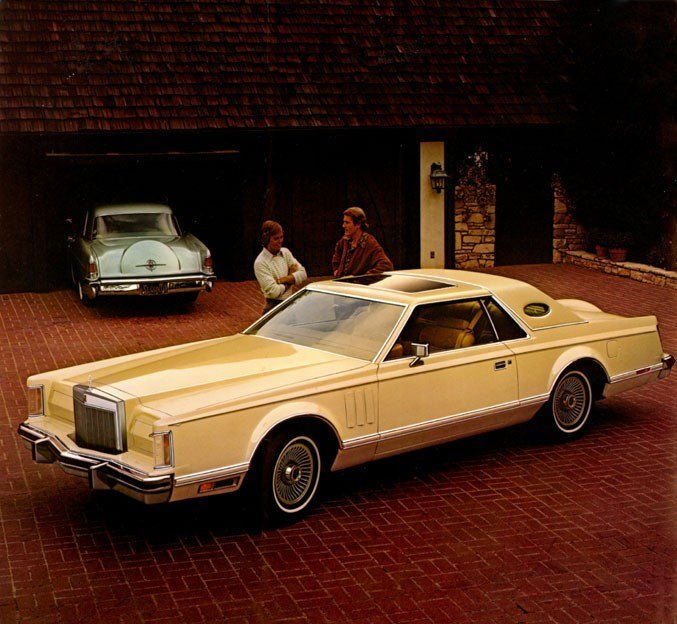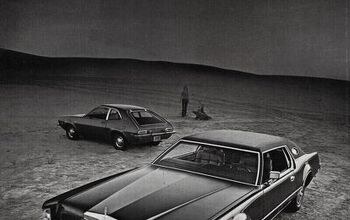Rare Rides Icons: The Lincoln Mark Series Cars, Feeling Continental (Part XXII)

In the last installment of our Lincoln Mark coverage, we learned about some new objectives Lincoln brass pursued for the transition from Mark IV to Mark V. There were two primary goals in mind: Cut development costs, and simultaneously allow the Mark more independence from Thunderbird. As a result, the Mark V of 1977 used the same platform as the old Mark IV, and Thunderbird was downsized to become a Mercury Cougar sibling. Further, in an attempt to move with the times and recognize that fuel economy mattered a little bit at the end of the Seventies, Lincoln engineers reworked the Mark IV platform for Mark V duty.
The chassis was fettled and updated notably in the transition from Mark IV to Mark V. Unlike its predecessor, the Mark V was designed after fuel economy entered the US public’s consciousness courtesy of the 1973 OPEC crisis. To that end, engineers cut about 400 pounds of weight from Mark IV to Mark V, even though the latter was a larger car.
And a diet wasn’t the only nod to fuel economy, as the Mark V arrived with two different engine options, a first. The base Mark V engine had the smallest displacement of any Lincoln or Continental model since 1957: It was a 400 cubic inch (6.6L) Cleveland V8 shared with the Thunderbird and Cougar. With a two-barrel carb, it managed an unimpressive 179 horsepower and 329 lb-ft of torque.
For the customer who cared less about saving at the pump, the 460 cubic inch (7.5L) 385 V8 returned for a follow-up performance after it powered the Mark III and Mark IV. However, even with a four-barrel Motorcraft carb under the hood, it made less power than before. Emissions sapped horsepower to 208, and torque to 356 lb-ft. Both engines delivered power via the same C6 automatic as before.
Though the Mark V’s wheelbase remained the same 120.4 inches as its predecessor, all other exterior dimensions changed. Length increased a couple of inches to 230.3 overall, which made the Mark V the largest Continental Mark ever. Overall width decreased marginally (likely down to the better-integrated bumpers) from 79.8” to 79.7”. Finally, overall height decreased notably, from 53.5 inches in 1976 to 52.9” in 1977.
Longer and lower was the name of the game in the late Seventies, and the PLC was at the forefront of that styling trend. As mentioned in our last installment, the styling that debuted on the Mark V was very important because it established the exterior design template Lincoln would use throughout the late Eighties. Almost all styling details on the new Mark were sharper than they were previously.
As the Mark’s waterfall grille was its trademark (and had spread to the Continental), Lincoln made almost no changes to it for Mark V duty. Examined closely, the vertical chromed slats were made thinner, and segmented into sections via a few thicker slats. The covered headlamps of the Mark IV returned, and their design was nearly identical as on the Mark IV.
A more notable change occurred below the lamps, where Lincoln’s designers had time to cope with and integrate the five-mile-per-hour bumpers. In place of the Mark IV’s battering ram look was a more angular bumper that came to a point in the middle, then wrapped around the front end to meet the fender more gracefully. There were still vertical bumper guards, but their dimensions were reduced, and their height was aligned with the bumper. The black trim strip on the bumper was carried over from the Mark IV but made thicker on Mark V to match the width of the body side trim.
Fitting the more angular design theme, corner indicator lamps were redesigned to be larger, with a sharper leading edge. Lenses were also more squared off and did not angle forward as on Mark IV. The cornering lamp gained an amber reflector as it now did double duty as an indicator. That meant the lower front fender lamp assembly was larger and situated further from the bumper for crash reasons.
Though the hood shape was roughly the same on Mark IV and V, the V’s fender line was much sharper than its predecessor. It’s very easy to draw a direct styling line from the Mark V’s looks all the way through the 1988 Town Car. The top edge of the fender continued uninterrupted through to the B-pillar, where it turned sharply upward to form the edge of the side window.
A secondary character line originated at the front fender and ran all the way to the rear corner, and was nearly horizontal. This styling detail was not present on Mark IV but gave the Mark V a much longer look from the side. The body side trim was revised as well: Though it had roughly the same placement as on the Mark IV, it did not wrap over the wheel arches. Instead chrome trim appeared there, and body molding picked up afterward.
Another new styling feature along the Mark V’s flanks were three fender vents. Nonfunctional, the vents were purely for some visual interest. That feature would also be picked up by the rest of the Continental line upon its new generation in 1980.
The Mark V debuted a new turbine wheel style that was popular in the late Seventies and took the Mark IV’s wheel to the next level (a wheel cover was also available). The turbine wheel was another cue Lincoln maintained through the late Eighties and spread to its other models. Importantly for PLC customers, the side opera window returned for Mark V duty. It grew larger than on the Mark IV, which was surely appreciated by rear-seat passengers.
Speaking of the rear, the Mark V’s hind quarters update was a bit less successful than its front end. There’s enough real estate to cover (several feet!) that we’ll save it for our next entry. Then we’ll move on to interior accommodation.
[Images: Ford]
Become a TTAC insider. Get the latest news, features, TTAC takes, and everything else that gets to The Truth About Cars first by subscribing to our newsletter.

Interested in lots of cars and their various historical contexts. Started writing articles for TTAC in late 2016, when my first posts were QOTDs. From there I started a few new series like Rare Rides, Buy/Drive/Burn, Abandoned History, and most recently Rare Rides Icons. Operating from a home base in Cincinnati, Ohio, a relative auto journalist dead zone. Many of my articles are prompted by something I'll see on social media that sparks my interest and causes me to research. Finding articles and information from the early days of the internet and beyond that covers the little details lost to time: trim packages, color and wheel choices, interior fabrics. Beyond those, I'm fascinated by automotive industry experiments, both failures and successes. Lately I've taken an interest in AI, and generating "what if" type images for car models long dead. Reincarnating a modern Toyota Paseo, Lincoln Mark IX, or Isuzu Trooper through a text prompt is fun. Fun to post them on Twitter too, and watch people overreact. To that end, the social media I use most is Twitter, @CoreyLewis86. I also contribute pieces for Forbes Wheels and Forbes Home.
More by Corey Lewis
Latest Car Reviews
Read moreLatest Product Reviews
Read moreRecent Comments
- Carson D Just don't be the whistleblower who reports on the falsification of safety data. That's a deadly profession.
- Carson D I'd have responded sooner, but my computer locked up and I had to reboot it.
- Todd In Canada Mazda has a 3 year bumper to bumper & 5 year unlimited mileage drivetrain warranty. Mazdas are a DIY dream of high school auto mechanics 101 easy to work on reliable simplicity. IMO the Mazda is way better looking.
- Tane94 Blue Mini, love Minis because it's total custom ordering and the S has the BMW turbo engine.
- AZFelix What could possibly go wrong with putting your life in the robotic hands of precision crafted and expertly programmed machinery?





































Comments
Join the conversation
Corey--We know but we still want to give our support to you and let TTAC know that your articles are excellent and better than what the typical articles are.
I'll certainly admit to a bit of nostalgia that drives my appreciation for these 70's yachts, but there's more to it than that. It was an era that the Big 3 ruled the luxury market with the German's and British nothing but a beer fart in the marketplace. That changed drastically as the early '80s crept in but in 1977, a Mark V or Seville was where it was at. No rose colored glasses, they were not great cars, what they were was a great living room that you could ride to the office in. I grew up on a diet of Cadillac's, Lincoln and one big Chrysler before dad made the move to a 280SE in about '77. Impeccably built and very road worthy, dad initially didn't like the firm seats, clunky automatic transmission and very weak A/C. The exorbitant maintenance costs didn't help. But he enjoyed the driving characteristics enough to get another Benz, then a 733i, an Audi 5000S and a Jag XJ6. Compare these to today's Cadillac's (non- V) and Lincoln's that with the exception of the Escalade and Navigator, are boring and probably even more pedestrian than the Eldorado, Seville and Mark's were.